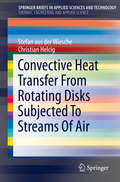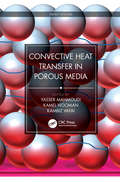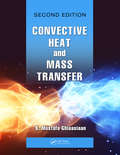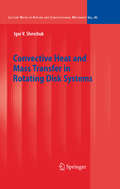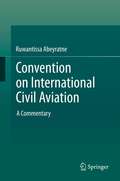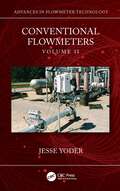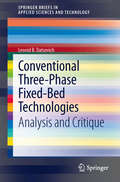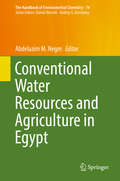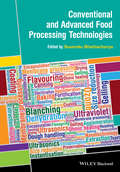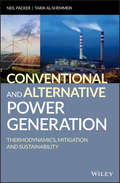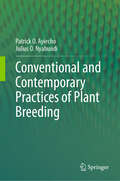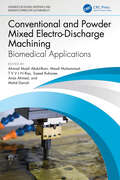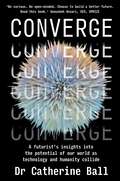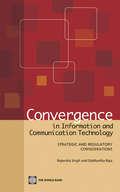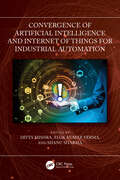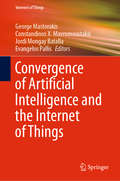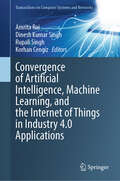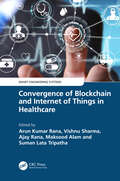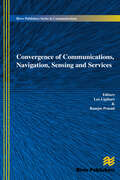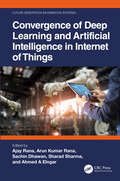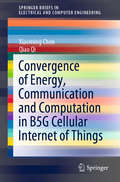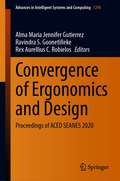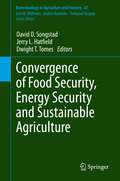- Table View
- List View
Convective Heat Transfer From Rotating Disks Subjected To Streams Of Air (SpringerBriefs in Applied Sciences and Technology)
by Stefan aus der Wiesche Christian HelcigThis Brief describes systematically results of research studies on a series of convective heat transfer phenomena from rotating disks in air crossflow. Phenomena described in this volume were investigated experimentally using an electrically heated disk placed in the test section of a wind tunnel. The authors describe findings in which transitions between different heat transfer regimes can occur in dependency on the involved Reynolds numbers and the angle of incidence, and that these transitions could be related to phenomenological Landau and Landau-de Gennes models. The concise volume closes a substantial gap in the scientific literature with respect to flow and heat transfer in rotating disk systems and provides a comprehensive presentation of new and recent results not previously published in book form.
Convective Heat Transfer in Porous Media (Energy Systems)
by Kambiz Vafai Yasser Mahmoudi Kamel HoomanFocusing on heat transfer in porous media, this book covers recent advances in nano and macro’ scales. Apart from introducing heat flux bifurcation and splitting within porous media, it highlights two-phase flow, nanofluids, wicking, and convection in bi-disperse porous media. New methods in modeling heat and transport in porous media, such as pore-scale analysis and Lattice–Boltzmann methods, are introduced. The book covers related engineering applications, such as enhanced geothermal systems, porous burners, solar systems, transpiration cooling in aerospace, heat transfer enhancement and electronic cooling, drying and soil evaporation, foam heat exchangers, and polymer-electrolyte fuel cells.
Convective Heat and Mass Transfer (Heat Transfer)
by S. Mostafa GhiaasiaanConvective Heat and Mass Transfer, Second Edition, is ideal for the graduate level study of convection heat and mass transfer, with coverage of well-established theory and practice as well as trending topics, such as nanoscale heat transfer and CFD. It is appropriate for both Mechanical and Chemical Engineering courses/modules.
Convective Heat and Mass Transfer in Rotating Disk Systems (Lecture Notes in Applied and Computational Mechanics #45)
by Igor V. ShevchukThe book describes results of investigations of a series of convective heat and mass transfer problems in rotating-disk systems, namely, over free rotating disks, under conditions of transient heat transfer, solid- body rotation of fluid, orthogonal flow impingement onto a disk, swirl radial flow between parallel co-rotating disks, in cone-disk systems and for Prandtl and Schmidt numbers larger than unity. Methodology used included integral methods, self-similar and approximate analytical solutions, as well as CFD. The book is aimed at the professional audience of academic researchers, industrial R&D engineers, university lecturers and graduate/postgraduate students working in the area of rotating-disk systems.
Convention on International Civil Aviation: A Commentary
by Ruwantissa AbeyratneThis book is both a repertory guide to the Convention on International Civil Aviation (Chicago Convention) as well as a legal analysis of the provisions of the treaty. It traces action taken by the ICAO Assembly and the Council in the implementation of the Convention from the first ICAO Assembly in 1947 until 2012. Above all, the book offers a commentary on the functional and moral fabric of the Chicago Convention, which is not only a multilateral legal instrument that sets out basic principles of air navigation and air transport, but also serves as a moral compass that brings the people of the world together. The teleological nature of the Chicago Convention is reflected from the outset - from its Preamble which sets the tone and philosophy of the Convention - that aviation builds friendship and understanding among all people, to its technical provisions that range from rules of the air to landing at airports and customs and immigration procedures. The book effectively demonstrates the Aristotelian principle - that rules make people good by forming habits in them. Standardization, or in other words, compliance, is the driver of the Convention that keeps aviation safe, regular, efficient and economical. To that end, this book traces and details the sustained relevance of the Chicago Convention and the efforts of ICAO and the international aviation community towards keeping air transport on track and ready for its future exponential growth, both in letter and in spirit.
Conventional Flowmeters: Volume II
by Jesse YoderConventional Flowmeters covers origin, principle of operation, development, advantages and disadvantages, applications, and frontiers of research for conventional technology flowmeters, which include differential pressure and primary elements, positive displacement, turbine, open channel, and variable area. There are more conventional technology meters being used in the field than new-technology meters. New developments, such as more accurate pressure transmitters, new primary elements such as cone elements, reversible flow, and dual rotor turbine meters, and variable area meters with transmitters and a signal output, are discussed. Features: Offers a working knowledge of the origin and development of the more traditional technology flowmeters: differential pressure and primary elements, positive displacement, turbine, open channel, and variable area Describes how these conventional meters still fit into what is being called Industry 4.0 Discusses the advantages and disadvantages of conventional technology meters and provides a rationale for retaining or replacing these meters Focuses on the origin, development operating principles, and applications for the meters Explores the development of each conventional flowmeter type, including the roles of companies such as Siemens, ABB, Emerson, Foxboro, KROHNE, and Endress+Hauser This book is designed for anyone involved with flowmeters and instrumentation, including product and marketing managers, strategic planners, application engineers, and distributors.
Conventional Three-Phase Fixed-Bed Technologies: Analysis and Critique (SpringerBriefs in Applied Sciences and Technology #7)
by Leonid B. DatsevichThis book analyzes conventional fixed-bed reactors such as trickle-bed, bubble (packed) column, and multitubular reactors with regard to process efficiency, design and safety. It is shown that these reactors do not possess any substantial potential for improving industrial processes. Modern concepts in mass transfer, kinetics and process design are applied to process development. In light of the given analysis, new approaches to the development of technologies based on innovative principles are elucidated. For the first time, first-hand knowledge about Two-Zone Model, Oscillation Theory, map of the energy dissipation is presented in full.
Conventional Water Resources and Agriculture in Egypt (The Handbook of Environmental Chemistry #74)
by Abdelazim M. NegmThis unique volume focuses on Egypt’s conventional water resources and the main water consumer: Egypt’s agriculture. It provides an up-to-date overview and the latest research findings, and covers the following main topics: · History of irrigation and irrigation projects · Key features of agriculture, the administrative and legal framework in Egypt · Land resources for agriculture development · Food insecurity due to water shortages and climate change; resulting challenges and opportunities · Assessment of water resources for irrigation and drinking purposes · Impacts of upstream dams, such as the GERD and Tekeze Dam, on Egypt’s water resources and crop yield · Sustainable use of water resources and the future of mega irrigation projects · Quantity and quality of water in Egypt’s water resources bank This book and the companion volume Unconventional Water Resources and Agriculture in Egypt offer invaluable reference guides for postgraduates, researchers, professionals, environmental managers and policymakers interested in water resources and their management worldwide.
Conventional and Advanced Food Processing Technologies
by Suvendu BhattacharyaFood processing technologies are an essential link in the food chain. These technologies are many and varied, changing in popularity with changing consumption patterns and product popularity. Newer process technologies are also being evolved to provide the added advantages. Conventional and Advanced Food Processing Technologies fuses the practical (application, machinery), theoretical (model, equation) and cutting-edge (recent trends), making it ideal for industrial, academic and reference use. It consists of two sections, one covering conventional or well-established existing processes and the other covering emerging or novel process technologies that are expected to be employed in the near future for the processing of foods in the commercial sector. All are examined in great detail, considering their current and future applications with added examples and the very latest data. Conventional and Advanced Food Processing Technologies is a comprehensive treatment of the current state of knowledge on food processing technology. In its extensive coverage, and the selection of reputed research scientists who have contributed to each topic, this book will be a definitive text in this field for students, food professionals and researchers.
Conventional and Alternative Power Generation: Thermodynamics, Mitigation and Sustainability
by Tarik Al-Shemmeri Neil PackerA much-needed, up-to-date guide on conventional and alternative power generation This book goes beyond the traditional methods of power generation. It introduces the many recent innovations on the production of electricity and the way they play a major role in combating global warming and improving the efficiency of generation. It contains a strong analytical approach to underpin the theory of power plants—for those using conventional fuels, as well as those using renewable fuels—and looks at the problems from a unique environmental engineering perspective. The book also includes numerous worked examples and case studies to demonstrate the working principles of these systems. Conventional and Alternative Power Generation: Thermodynamics, Mitigation and Sustainability is divided into 8 chapters that comprehensively cover: thermodynamic systems; vapor power cycles, gas power cycles, combustion; control of particulates; carbon capture and storage; air pollution dispersal; and renewable energy and power plants. Features an abundance of worked examples and tutorials Examines the problems of generating power from an environmental engineering perspective Includes all of the latest information, technology, theories, and principles on power generation Conventional and Alternative Power Generation: Thermodynamics, Mitigation and Sustainability is an ideal text for courses on mechanical, chemical, and electrical engineering.
Conventional and Contemporary Practices of Plant Breeding
by Patrick O. Ayiecho Julius O. NyabundiThis book covers some established conventional and recent advances in plant breeding methods. It highlights and treats in detail some breeding strategies not adequately handled or usually ignored in many plant breeding texts. There is in-depth coverage of plant resistance mechanisms to various stress factors and application of phenotyping, genotyping, bioinformatics, molecular markers, ‘omics’ technologies, biotechnology, transgenesis and gene editing in crop improvement. Topics like germplasm conservation, plant sex expression and pollination control, recurrent selection methods, interspecific hybridisation, pre-breeding, chromosome manipulation and breeding for resistance to diseases and insect pests are comprehensively covered. The book gives special attention to some problems that affect food security in developing countries, e.g., parasitic weeds and drought and heat stress. Breeding for resistance to parasitic weeds like Striga, broomrapes and Cascuta is always ignored in most plant breeding texts. Where applicable, problems and challenges associated with some breeding strategies are highlighted and possible solutions proposed. The text is rich in relevant examples for various topics. The book is suitable for teaching of plant breeding at the university level and is also beneficial to practising plant breeders. It brings together some relevant work and literary information that is useful to university lecturers, students and practising plant breeders. The book targets university students in agricultural and plant sciences, particularly those taking plant breeding as a key unit/course.
Conventional and Powder Mixed Electro-Discharge Machining: Biomedical Applications (Advances in Design, Materials and Manufacturing for Sustainability)
by Abdul-Rani, Ahmad Majdi Masdi Muhammad Rao, T V V L N Saeed Rubaiee Anas Ahmed Mohd DanishThis book presents the evolution of the electro-discharge machining (EDM) process from conventional EDM to powder mixed EDM with emphases on biomedical applications. It discusses the theory behind each process and their applications in the field of biomedical research, and presents a brief background to various EDM processes, current research challenges, and detailed case studies of powder mixed EDM of various materials. It also includes a state-of-the-art review of the EDM process.Features: Focuses on biomedical implant and device manufacturing using commercialization of powder mixed electro-discharge machining (PM-EDM) technology Discusses surface modification of biomaterials through the PM-EDM process Reviews processing of the metallic biomaterials for biomedical applications Explores optimization of the process factors for achieving optimal responses using NSGA-II Includes comprehensive mechanism and application details of the PM-EDM process This book is aimed at graduate students and researchers in manufacturing, production, materials, and biomedical engineering.
Converge: A futurist's insights into the potential of our world as technology and humanity collide
by Catherine BallMulti-award-winning scientific futurist Dr. Catherine Ball presents insights into how technology and science are providing answers to many of the challenges the world is facing today— food shortages, war and conflict, the decline in local manufacturing, health and ageing, and global warming— and asks why we are not embracing these technologies mo.re widely. The answer in many cases is, 'Because we don't know about them!' Well, now we do. Dr Catherine opens our eyes to the amazing, wide world of technological advancements and explores the role we all have in learning more, owning the conversations, and determining what we want technology to be. What is the role AI can play in the resurgence of local manufacturing and creating new jobs? Can we vaccinate against cancer? How can drones save lives and assist Mother Nature in her fight to stop humans destroying our beloved planet? And how can we utilise the best modern technologies to live longer, healthier, and happier lives? Written with wit, tenacity, and deeply personal experiences, Converge offers an optimistic, in-depth, and fascinating investigation into the possibilities of a world where humans fully embrace technology.
Converged Communications: Evolution from Telephony to 5G Mobile Internet
by Erkki KoivusaloCONVERGED COMMUNICATIONS A one-of-a-kind exploration of the past, present, and future of telecommunications In Converged Communications: Evolution from Telephony to 5G Mobile Internet, telecommunications industry veteran Erkki Koivusalo delivers an essential reference describing how different communications systems work, how they have evolved from fixed telephone networks to the latest 5G mobile systems, and how the voice and data services converged. The central theme of the book is to build deeper understanding about incremental technological progress by introducing both state of the art and their predecessor technologies. The book explores four main areas, including fixed telephone systems, data communication systems, mobile cellular systems, and IP multimedia systems. It clearly explains architectures, protocols, and functional procedures, and discusses a variety of topics ranging from physical layer processes to system level interactions. Converged Communications offers: In-depth treatments of fixed telephone and transmission systems, including operation of telephone exchanges and signaling systems Comprehensive explorations of data communication systems, including transmission of data over telephone lines and data network technologies, such as Ethernet and TCP/IP Incisive discussions of mobile cellular systems, including GSM, 3G, LTE, VoLTE and 5G Insightful analysis of incremental system evolution to justify various design choices made The book is supported with extensive online appendices, which covers communication system concepts, an overview of standardization, various technologies used in the past, state-of-the art technologies such as WLAN, cable modems, and FTTx, complementing the other systems described in the book which have evolved from the fixed telephone network. Perfect for network operators, system integrators, and communication system vendors, Converged Communications: Evolution from Telephony to 5G Mobile Internet will also earn a place in the libraries of undergraduate and graduate students studying telecommunications and mobile systems. Constructive comments and improvement proposals about Converged Communications or its online appendices can be sent by email to address converged.communications.book@gmail.com. The feedback will be considered for possible new editions of the book or the revisions of the appendices.
Convergence in Information and Communication Technology
by Siddhartha Raja Rajendra SinghGrowth in the information and communication technology (ICT) sector has exploded over the past 20 years. Continuous dynamic market and technology developments in this sector have led to a phenomenon known as convergence, which is defined in this volume as the erosion of boundaries between previously separate ICT services, networks, and business practices. Some examples include cable television networks that offer phone service, Internet television, and mergers between media and telecommunications firms. The results are exciting and hold significant promise for developing countries, which can benefit from expanded access, greater competition, and increased investments. However, convergence in ICT is challenging traditional policy and regulatory frameworks. With convergence occurring in countries across the spectrum of economic development, it is critical that policy makers and regulators understand and respond in ways that maximize the benefits while mitigating the risks. This volume analyzes the strategic and regulatory dimensions of convergence. It offers policy makers and regulators examples from countries around the world as they address this phenomenon. The authors suggest that countries that enable convergence are likely to reap the greater rewards, but the precise nature of the response will vary by country. Hence, this book offers global principles that should be tailored to local circumstances as regulatory frameworks evolve to address convergence.
Convergence of Artificial Intelligence and Internet of Things for Industrial Automation
by Divya Mishra Shanu Sharma Alok Kumar VermaThis book begins by discussing the fundamentals of Artificial Intelligence, the Internet of Things, and their convergence. It then covers techniques, algorithms, and methods of analysing and processing data over the Artificial Intelligence of Things. The text elaborates on important concepts such as body sensor networks for safety in smart factories, smart energy management, smart robotic assistive systems, and service-oriented smart manufacturing.This book:• Discusses the security and privacy aspect of Artificial Intelligence of Things (AIoT) for smart real-time applications.• Explores challenges and issues of Artificial Intelligence and the Internet of Things in the field of industrial automation.• Includes case studies in Artificial Intelligence of Things (AIoT) convergence for data processing.• Showcases algorithms, techniques, and methods of analysing and processing data over the Artificial Intelligence of Things.• Highlights operation management using human-robot, smart maintenance, and autonomous production.It will serve as an ideal reference text for senior undergraduate, graduate students, and professionals in fields including industrial engineering, production engineering, manufacturing engineering, operations research, and computer engineering.
Convergence of Artificial Intelligence and the Internet of Things (Internet of Things)
by Constandinos X. Mavromoustakis George Mastorakis Jordi Mongay Batalla Evangelos PallisThis book gathers recent research work on emerging Artificial Intelligence (AI) methods for processing and storing data generated by cloud-based Internet of Things (IoT) infrastructures. Major topics covered include the analysis and development of AI-powered mechanisms in future IoT applications and architectures. Further, the book addresses new technological developments, current research trends, and industry needs. Presenting case studies, experience and evaluation reports, and best practices in utilizing AI applications in IoT networks, it strikes a good balance between theoretical and practical issues. It also provides technical/scientific information on various aspects of AI technologies, ranging from basic concepts to research grade material, including future directions. The book is intended for researchers, practitioners, engineers and scientists involved in the design and development of protocols and AI applications for IoT-related devices. As the book covers a wide range of mobile applications and scenarios where IoT technologies can be applied, it also offers an essential introduction to the field.
Convergence of Artificial Intelligence, Machine Learning, and the Internet of Things in Industry 4.0 Applications (Transactions on Computer Systems and Networks)
by Amrita Rai Dinesh Kumar Singh Rupali Singh Korhan Cengi̇zThe book offers valuable insights into research related to Industry 4.0 applications that utilize artificial intelligence (AI), machine learning (ML), and the Industrial Internet of Things (IIoT). Industry 4.0, also known as the Fourth Industrial Revolution, includes disruptive technologies such as the Internet of Things (IoT), robotics, virtual reality (VR), VLSI architecture, and AI, all of which are transforming modern society and manufacturing practices. This book addresses various aspects of smart industrial application design strategies and their effects on next-generation systems, including quantum computing, edge computing, IoT, cybersecurity, nano-communications, and robotic automation. The application of AI, machine learning techniques, and IoT is anticipated to improve the performance of automated and controlled systems. Intended as a resource for academics, researchers, and professionals in the fields of AI and ML, the content also explores their applications within the industrial revolution and the influence of VLSI on the global market. Additionally, the book serves as a reference for developing sustainable engineering solutions to address various global industrial challenges.
Convergence of Blockchain and Internet of Things in Healthcare (Smart Engineering Systems: Design and Applications)
by Arun Kumar Rana, Vishnu Sharma, Ajay Rana, Maksud Alam and Suman Lata TripathiThe Internet of Things (IoT) and blockchain are two new technologies that combine elements in many ways. A system where the virtual and physical worlds interact is created by integrating pervasive computing, ubiquitous computing, communication technologies, sensing technologies, Internet Protocol, and embedded devices. A massive number of linked devices and vast amounts of data present new prospects for developing services that can directly benefit the economy, environment, society, and individual residents. Due to the size of IoT and insufficient data security, security breaches may have a huge impact and negative effects. IoT not only connects gadgets but also people and other entities, leaving every IoT component open to a wide variety of assaults. The implementation and application of IoT and blockchain technology in actual scientific, biomedical, and data applications are covered in this book. The book highlights important advancements in health science research and development by applying the distinctive capabilities inherent to distributed ledger systems. Each chapter describes the current uses of blockchain in real-world data collection, medicine development, device tracking, and more meaningful patient interaction. All of these are used to create opportunities for expanding health science research. This paradigm change is studied from the perspectives of pharmaceutical executives, biotechnology entrepreneurs, regulatory bodies, ethical review boards, and blockchain developers.Key Features: Provides a foundation for the implementation process of blockchain and IoT devices based on healthcare-related technology Image processing and IoT device researchers can correlate their work with other requirements of advanced technology in the healthcare domain Conveys the latest technology, including artificial intelligence and machine learning, in healthcare-related technology Useful for the researcher to explore new things like security, cryptography, and privacy in healthcare related technology Tailored for people who want to start in healthcare-related technology with blockchain and IoT This book is primarily for senior undergraduates, graduate students, and academic researchers in the fields of electrical engineering, electronics and communication engineering, computer science and engineering, and biomedical engineering.
Convergence of Blockchain, AI, and IoT: Concepts and Challenges (Innovations in Big Data and Machine Learning)
by R. IndrakumariConvergence of Blockchain, AI, and IoT: Concepts and Challenges discusses the convergence of three powerful technologies that play into the digital revolution and blur the lines between biological, digital, and physical objects. This book covers novel algorithms, solutions for addressing issues in applications, security, authentication, and privacy. The book provides an overview of the clinical scientific research enabling smart diagnosis equipment through AI. It presents the role these technologies play in augmented reality and blockchain, covers digital currency managed with bitcoin, and discusses deep learning and how it can enhance human thoughts and behaviors. Targeted audiences range from those interested in the technical revolution of blockchain, big data and the Internet of Things, to research scholars and the professional market.
Convergence of Communications, Navigation, Sensing and Services (River Publishers Series In Communications Ser.)
by Ramjee Prasad Leo LigthartActivities on integrated communications, navigation, sensing and services are urgently needed in a wide range of human-centered and/or device-centered system applications. They require a multi-disciplinary approach. It is foreseen that the economic scale of these activities are comparable with the present scale of wireless communications. The area in which systems operate can vary from personal area network to global network.This book covers the following topics;• CONASENSE Architecture• Performance Analyses of Integrated Communication Systems• Cognitive Radio Networks• Brain Computer Interfacing• Quality Improvement of Generic Services• Machine to Machine communications• Chip to Chip CommunicationsThus, the multi-disciplinary approach get attention in the book.
Convergence of Deep Learning and Artificial Intelligence in Internet of Things (Future Generation Information Systems)
by Ahmed A. Elngar Arun Kumar Rana Sharad Sharma Sachin Dhawan Ajay RanaThis book covers advances and applications of smart technologies including the Internet of Things (IoT), artificial intelligence, and deep learning in areas such as manufacturing, production, renewable energy, and healthcare. It also covers wearable and implantable biomedical devices for healthcare monitoring, smart surveillance, and monitoring applications such as the use of an autonomous drone for disaster management and rescue operations. It will serve as an ideal reference text for senior undergraduate, graduate students, and academic researchers in the areas such as electrical engineering, electronics and communications engineering, computer engineering, and information technology. • Covers concepts, theories, and applications of artificial intelligence and deep learning, from the perspective of the Internet of Things. • Discusses powers predictive analysis, predictive maintenance, and automated processes for making manufacturing plants more efficient, profitable, and safe. • Explores the importance of blockchain technology in the Internet of Things security issues. • Discusses key deep learning concepts including trust management, identity management, security threats, access control, and privacy. • Showcases the importance of intelligent algorithms for cloud-based Internet of Things applications. This text emphasizes the importance of innovation and improving the profitability of manufacturing plants using smart technologies such as artificial intelligence, deep learning, and the Internet of Things. It further discusses applications of smart technologies in diverse sectors such as agriculture, smart home, production, manufacturing, transport, and healthcare.
Convergence of Energy, Communication and Computation in B5G Cellular Internet of Things (SpringerBriefs in Electrical and Computer Engineering)
by Xiaoming Chen Qiao QiThis book focuses on the convergence of energy, communication and computation in the beyond 5G (B5G) cellular Internet of Things (IoT). It addresses both theory and techniques, with more weight placed on the latter. This is achieved by providing in-depth studies on a number of major topics such as wireless power transfer, non-orthogonal multiple access, massive multiple-input multiple-output, and over-air computation. In turn, four typical convergence scenarios are studied in detail: the convergence of energy and communication, convergence of energy and computation, convergence of communication and computation, and convergence of energy, communication and computation. The comprehensive and systematic coverage of key techniques in the convergence of energy, communication and computation in the B5G cellular IoT is one of the book’s major features, making it particularly well suited for readers who are interested in learning about practical solutions in B5G wireless networks. Accordingly, the book offers a valuable resource for researchers, engineers, and graduate students in the fields of information engineering, telecommunications engineering, computer engineering, etc.
Convergence of Ergonomics and Design: Proceedings of ACED SEANES 2020 (Advances in Intelligent Systems and Computing #1298)
by Ravindra S. Goonetilleke Alma Maria Jennifer Gutierrez Rex Aurellius C. RobielosThis book presents the proceedings of the Joint Conference of the Asian Council on Ergonomics and Design and Southeast Asian Network of Ergonomics Societies (ACED SEANES), held on December 2-4, 2020. By highlighting the latest theories and models, as well as cutting-edge technologies and applications, and by combining findings from a range of disciplines including engineering, design, robotics, healthcare, management, computer science, human biology and behavioral science, it provides researchers and practitioners alike with a comprehensive, timely guide on human factors and ergonomics. It also offers an excellent source of innovative ideas to stimulate future discussions and developments aimed at applying knowledge and techniques to optimize system performance, while at the same time promoting the health, safety and wellbeing of individuals. The proceedings include papers from researchers and practitioners, scientists and physicians, institutional leaders, managers and policy makers that contribute to constructing the Human Factors and Ergonomics approach across a variety of methodologies, domains and productive sectors.
Convergence of Food Security, Energy Security and Sustainable Agriculture (Biotechnology in Agriculture and Forestry #67)
by Jerry L. Hatfield David D. Songstad Dwight T. TomesThis volume examines the interrelated fields of food security, energy security and sustainable agriculture as the key to a stable global agricultural platform and is arranged in six parts The first part is focused on policy considerations relating to food and energy security and sustainable agriculture The authors from this part include Former Under Secretary of Agriculture Gale Buchanan, Former Under Secretary of Energy Raymond Orbach (Chapter 1), Stephen Hughes, Bryan Moser and William Gibbons (Chapter 2) and Thomas Redick (Chapter 3) Part II addresses soil and water, which are two of the key components in secure and sustainable food production Authors from this part are Jerry Hatfield (Chapter 4) and Mahbub Alam, Sharon Megdal et al. (Chapter 5) The third part covers sustainable and secure food production specifically addressing genetically modified traits in Chapter 6 (James McWilliams) and omega-3 fatty acids in Chapter 7 (Jay Whelan et al. ) Agronomic implications relative to food security and sustainable agriculture are described in Part IV Authors include Ravi Sripada, Pradip Das et al. (Chapter 8), Duska Stojsin, Kevin Matson and Richard Leitz (Chapter 9) and S. H. Lee, David Clay and Sharon Clay (Chapter 10) International sustainable agriculture and food security is addressed in Part V with authors Jeff Vitale and John Greenplate (Chapter 11), Julie Borlaug et al. (Chapter 12) and Sylvester Oikeh et al. (Chapter 13) The final part covers the use of chemicals in sustainable agriculture and food/energy security with Leonard Gianessi and Ashley Williams communicating the role of herbicides and Harold Reetz emphasizing the importance of fertilizers both in maximizing crop yields to maintain a sustainable secure source for food production.
